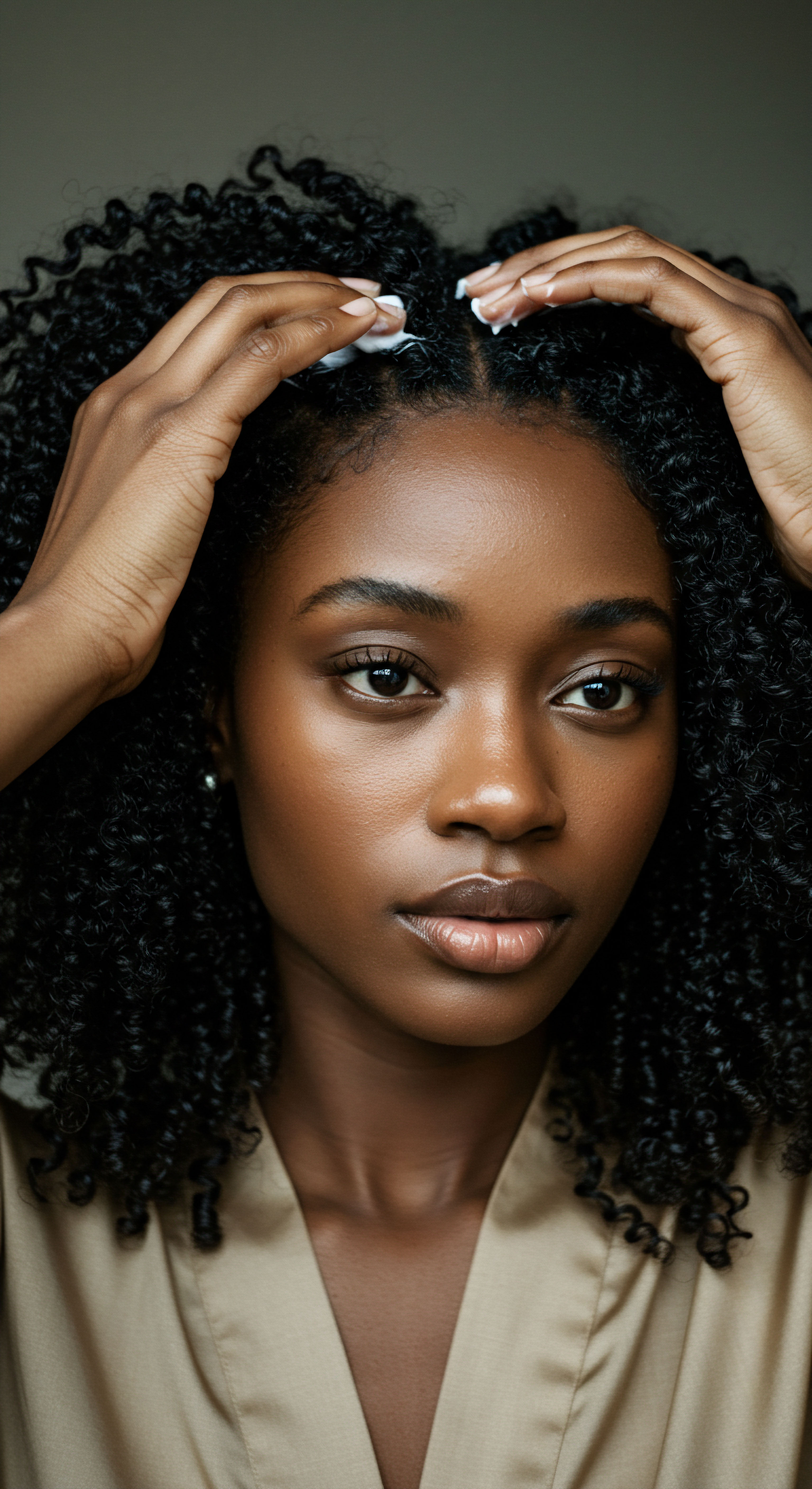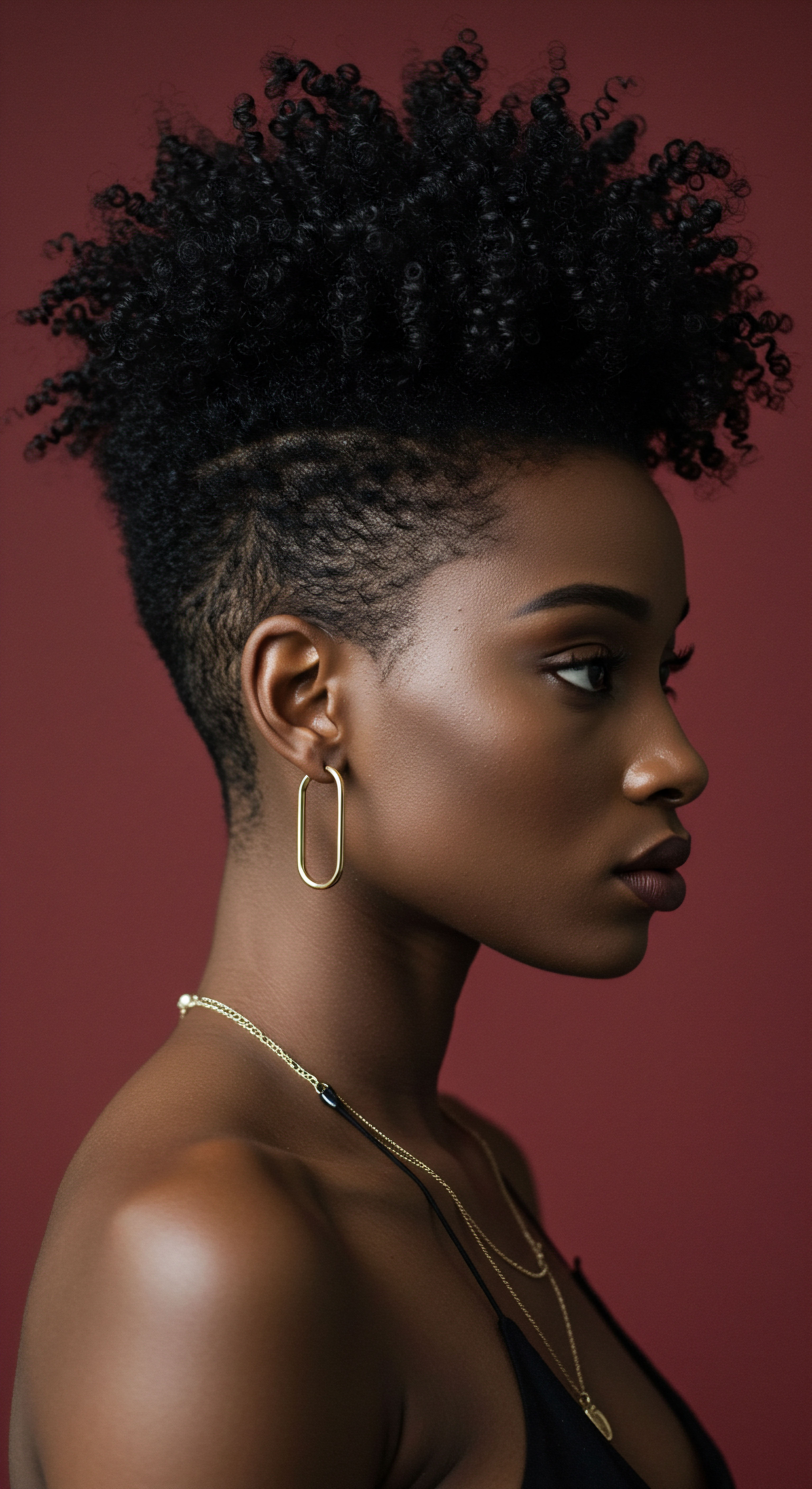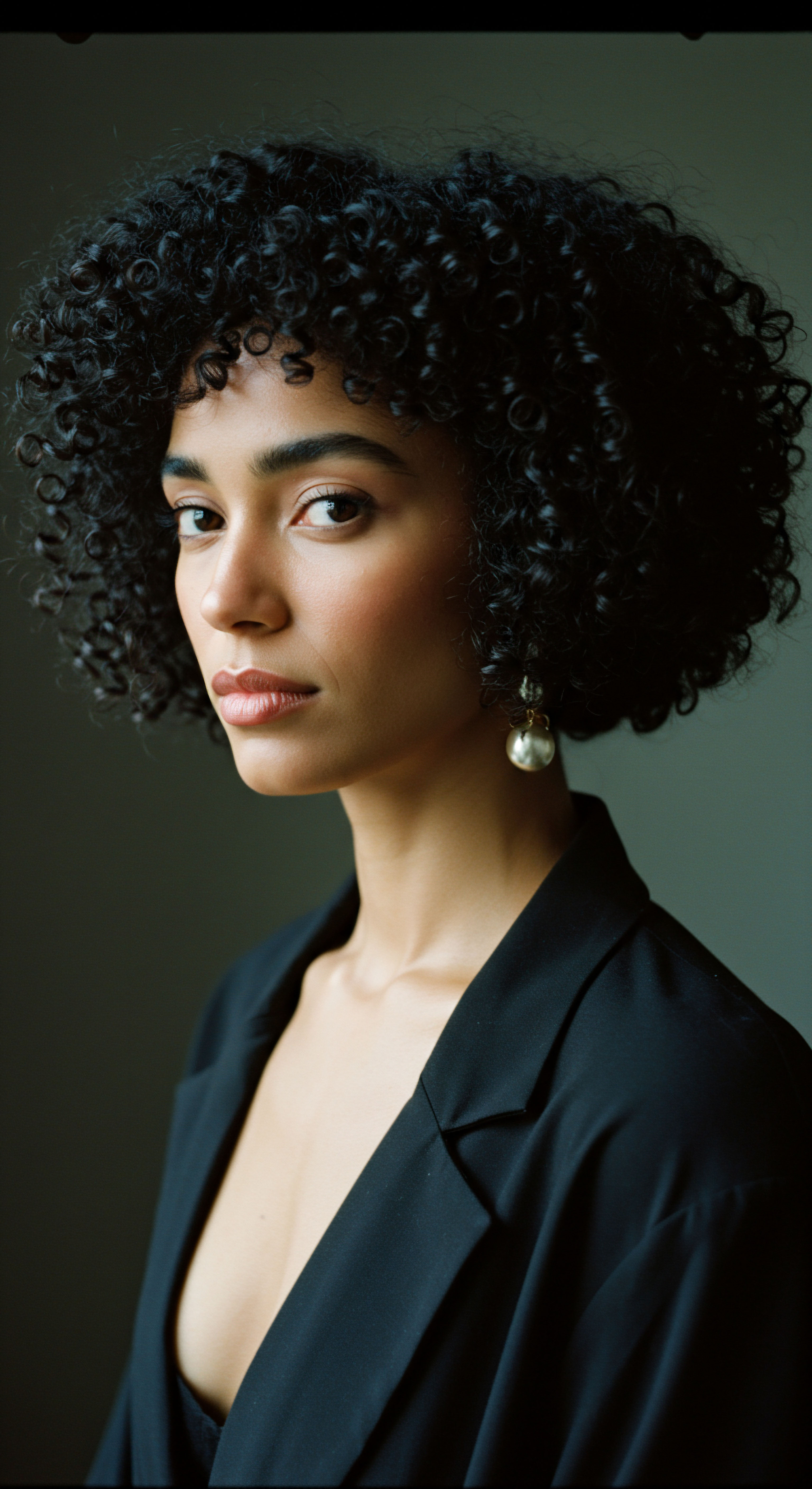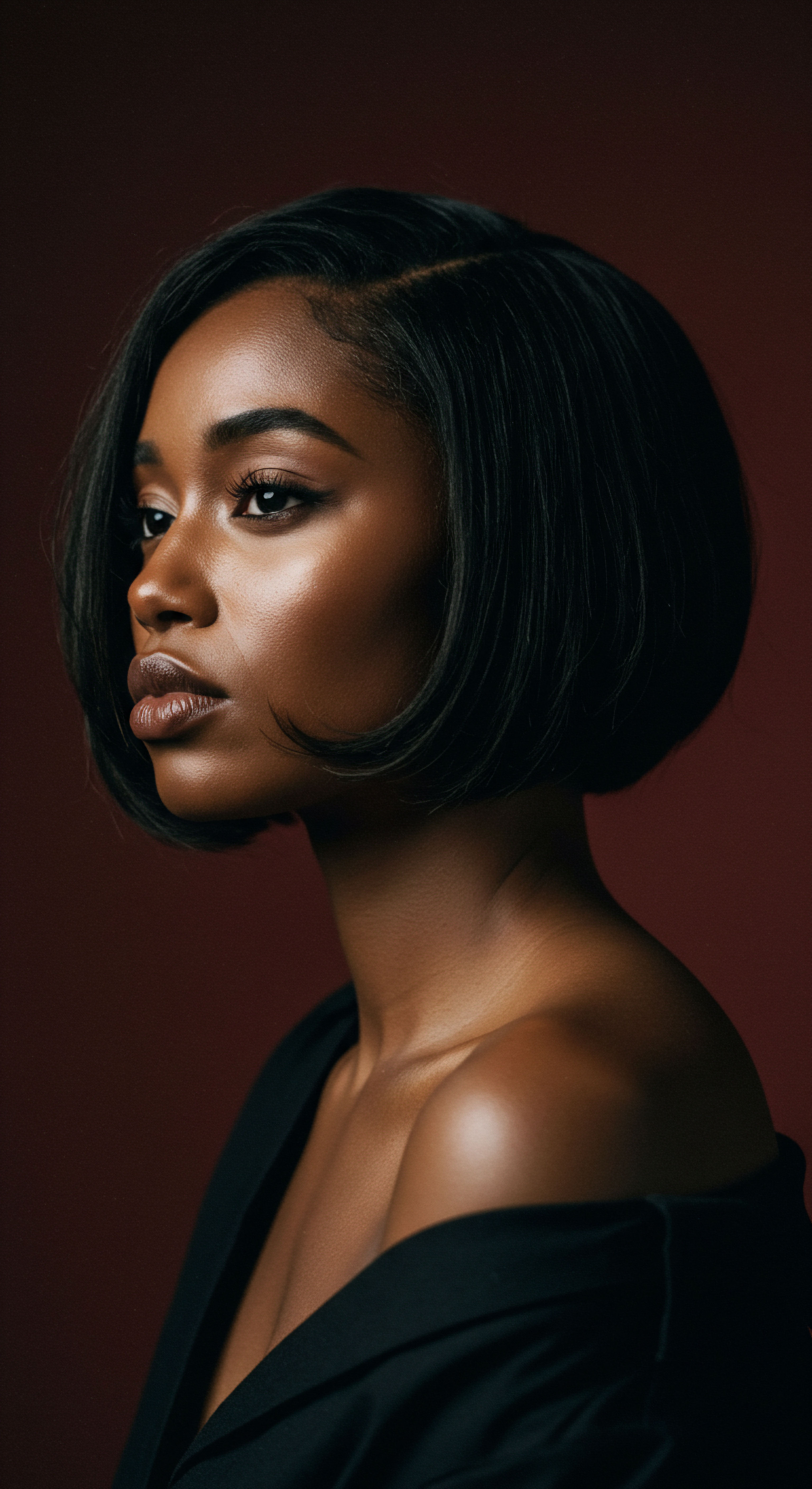The journey of hair, particularly textured hair, is a story written on our scalps, a testament to heritage, personal expression, and often, resilience. For many, the desire for a different texture has led to the use of chemical relaxers, products designed to straighten curls by altering the very structure of the hair shaft. Yet, as we delve into this practice, a crucial question arises ❉ can these chemical agents cause lasting scalp damage? The answer, like the delicate balance of our own hair, holds layers of complexity, intertwining chemistry, physiology, and lived experience.

Roots
The journey into understanding the impact of chemical hair relaxers on the scalp begins at the very foundation of our hair, its roots, and the intricate biology that sustains it. Our hair, a seemingly simple strand, is a marvel of biological engineering, with its origins deeply embedded within the scalp. Each follicle, a tiny organ, works tirelessly to produce the hair we see, a process profoundly affected by its surrounding environment. When we introduce powerful chemical agents, we are not simply altering the hair shaft; we are engaging with this delicate ecosystem, potentially disturbing its inherent balance.

The Anatomy of Hair and Scalp
To truly grasp the potential for damage, one must first appreciate the architecture of hair and scalp. The scalp, a specialized skin, serves as the anchor for countless hair follicles. Beneath its surface, these follicles extend into the dermis, where they are nourished by a rich supply of blood vessels and nerves.
The hair shaft itself, primarily composed of a protein called keratin, emerges from the follicle, protected by an outer layer of overlapping cells known as the cuticle. This cuticle acts as a shield, safeguarding the inner cortex and medulla, which determine the hair’s strength, elasticity, and curl pattern.
Chemical relaxers operate by penetrating this protective cuticle layer to reach the cortex. Their primary function involves disrupting the disulfide bonds, which are strong chemical linkages responsible for the hair’s natural curl. By breaking these bonds, the hair is able to be reshaped into a straighter form. The effectiveness of this process, however, hinges on a precise chemical reaction, and any deviation from optimal conditions can lead to unintended consequences for both the hair and the underlying scalp.
The pH of these products is a significant factor; lye relaxers, containing sodium hydroxide, typically possess a pH between 12 and 14, while no-lye formulations, often utilizing calcium hydroxide and guanidine carbonate, range from 9 to 11. This extreme alkalinity is what facilitates the breaking of bonds, but it also carries inherent risks for living tissue.

What are the Primary Chemical Agents in Hair Relaxers?
The landscape of chemical relaxers is primarily defined by two main categories ❉ lye and no-lye formulas. Each employs distinct active ingredients to achieve the desired straightening effect, and each carries its own set of considerations for scalp well-being. Understanding these components is a vital step in discerning the potential for lasting damage.
- Lye Relaxers ❉ These products contain sodium hydroxide as their active ingredient. Sodium hydroxide is a highly potent alkali, known for its ability to rapidly break down the hair’s disulfide bonds. Its efficacy in straightening hair is undeniable, but this very potency makes it a significant irritant to the skin and scalp. The swift action of lye relaxers necessitates extremely careful and precise application by experienced professionals to avoid immediate and severe chemical burns.
- No-Lye Relaxers ❉ Often marketed as gentler alternatives, no-lye relaxers typically use calcium hydroxide and guanidine carbonate. While they do not contain sodium hydroxide, they still generate a hydroxide ion during the mixing process, which is the active chemical responsible for altering the hair’s structure. These relaxers are often recommended for individuals with sensitive scalps, yet research indicates that even no-lye products can cause scalp burns as frequently as their lye-based counterparts. A notable side effect often associated with no-lye relaxers is calcium buildup on the hair shaft, which can lead to dryness over time.
- Thio Relaxers ❉ Less common for tightly coiled hair, thio relaxers utilize ammonium thioglycolate (ATG), similar to permanent waving solutions. These operate at a lower pH compared to hydroxide relaxers and require an oxidizing agent for neutralization. Overlapping these chemicals with hydroxide relaxers can lead to severe hair damage and loss.
The chemical alteration of hair is a permanent process. Once the disulfide bonds are broken and reformed, the hair’s natural curl pattern is fundamentally changed. This irreversible modification means that new growth will retain its original texture, requiring regular touch-ups to maintain a consistent appearance. This cyclical application, targeting only new growth, is where many of the long-term scalp concerns originate, as repeated exposure to these powerful chemicals can accumulate over time.
The scalp’s delicate balance faces a profound challenge from the extreme alkalinity of chemical relaxers, regardless of their lye or no-lye designation.

The Historical Context of Hair Alteration
The desire to alter hair texture is not a new phenomenon; it has roots deeply embedded in cultural and societal narratives. For Black women, in particular, hair relaxers emerged within a complex historical context, often intertwined with societal pressures and beauty standards. In the early 20th century, products designed to straighten afro-textured hair gained popularity, with figures like Garrett A. Morgan Sr.
developing early chemical relaxers containing lye. These innovations, while offering a means to achieve a straighter aesthetic, also reflected a period when European beauty ideals heavily influenced perceptions of acceptability and professionalism. The widespread adoption of relaxers became a common practice, a choice often made in response to external pressures to conform. This historical backdrop underscores that the conversation around relaxers extends beyond mere cosmetic preference, touching upon themes of identity, assimilation, and societal expectation. The long-standing relationship between these products and Black hair history means that the physical effects on the scalp are often experienced within a broader cultural narrative.
| Ingredient Type Sodium Hydroxide (Lye) |
| Mechanism of Action Breaks disulfide bonds rapidly, high pH (12-14) |
| Primary Scalp Impact Severe chemical burns, irritation, temporary hair loss |
| Ingredient Type Calcium Hydroxide & Guanidine Carbonate (No-Lye) |
| Mechanism of Action Forms guanidine hydroxide, slightly lower pH (9-11) |
| Primary Scalp Impact Burns, irritation, calcium buildup, dryness |
| Ingredient Type Ammonium Thioglycolate (Thio) |
| Mechanism of Action Breaks disulfide bonds, requires oxidation to reform |
| Primary Scalp Impact Less common for tight curls, potential for extreme damage if overlapped with hydroxide |
| Ingredient Type Understanding these active components is key to comprehending the direct interaction with scalp tissue. |

Ritual
Stepping from the foundational understanding of hair’s intrinsic nature, we arrive at the practical realm of hair care practices, particularly the recurring application of chemical relaxers. For many, the process of relaxing hair is more than a simple cosmetic treatment; it is a ritual, a periodic event that shapes appearance and, for some, holds cultural weight. This section explores the tangible manifestations of chemical relaxer use on the scalp, moving from the immediate sensations to the more enduring changes that can unfold over time. We seek to offer practical wisdom, recognizing that the choices made during these applications carry significant implications for scalp well-being.

Immediate Sensations and Early Warning Signs
The application of a chemical relaxer often begins with a characteristic tingling sensation on the scalp. This mild warmth is typically considered within the bounds of a normal reaction, an indication that the product is beginning its work. However, a fine line separates this expected sensation from a signal of distress. When the tingling intensifies into a distinct burning, resembling a “hot chicken grease” feeling, it becomes an urgent warning to take action.
This shift indicates that the scalp is experiencing a chemical burn, a direct consequence of the highly alkaline nature of the relaxer interacting with delicate skin. Such burns can range from first-degree redness and pain to more severe second- and third-degree injuries involving blistering and bleeding. These more serious burns elevate the risk of infection and may require medical intervention.
It is important to understand that these adverse reactions are not solely a result of leaving the product on for too long. Even minimal contact can trigger chemical burns if an individual’s scalp is particularly sensitive to a specific formulation. Any break in the skin, whether from pre-existing irritation, scratching, or the chemical itself, creates a pathway for these potent substances to enter the body, potentially leading to systemic exposure.

How do Chemical Relaxers Cause Immediate Scalp Injury?
The immediate injury to the scalp from chemical relaxers primarily stems from their extreme pH, which is significantly higher than the natural, slightly acidic pH of the scalp (around 4.5-5.5). This drastic difference in pH causes a chemical reaction that can lead to ❉
- Protein Denaturation ❉ The high alkalinity of relaxers denatures the proteins in the skin cells of the scalp, effectively breaking down their structure. This is akin to how the product works on hair, but on living tissue, it results in damage and cell death.
- Irritant Contact Dermatitis ❉ This is a common reaction where the skin becomes inflamed, red, itchy, and sometimes flaky due to direct contact with an irritating substance. The corrosive nature of relaxers makes this a frequent occurrence.
- Chemical Burns ❉ As mentioned, the direct corrosive action of the chemicals can lead to burns of varying degrees. These burns can cause pain, redness, blistering, and in severe cases, open sores. Open sores present a serious risk, as they can become infected and create a pathway for chemicals to enter the bloodstream.
A study in Kenya, for instance, found that 67% of women with Afro hair reported local effects after using different brands of hair relaxers, with pain and desquamation on the scalp, allergic reactions, and burns being among the most frequently mentioned.
The burning sensation felt during relaxer application is not a mere discomfort; it is the scalp’s urgent plea for immediate attention, signaling chemical assault.

Longer-Term Manifestations and Scalp Health Concerns
Beyond the immediate, acute reactions, repeated exposure to chemical relaxers can contribute to a spectrum of longer-term scalp health concerns. These issues often develop subtly, accumulating over years of consistent application, making their connection to relaxer use less immediately apparent but no less significant.
One of the most concerning long-term effects is the increased risk of certain forms of hair loss, particularly Central Centrifugal Cicatricial Alopecia (CCCA). CCCA is a type of scarring alopecia that primarily affects women of African descent, causing permanent hair loss as hair follicles are destroyed and replaced by scar tissue. While the exact cause of CCCA is considered multifactorial, hair care practices, including the use of chemical relaxers, have been consistently implicated.
Studies have observed that patients experiencing acute irritative symptoms during the relaxing process later developed areas of cicatricial alopecia, particularly at the crown of the scalp. The inflammation around the hair follicles, induced by these chemicals, can eventually lead to irreversible damage and scarring.
Other enduring concerns include chronic scalp irritation, dryness, and a compromised scalp barrier. The repeated chemical assault can strip the scalp of its natural oils, leading to persistent dryness and flaking. This disrupted barrier function can make the scalp more vulnerable to infections and sensitivities. A study involving 452 women with relaxed hair and 275 with natural hair found that women with relaxed hair experienced significantly more flaking of the scalp (P = 0.046), hair breakage (P = 0.023), and hair loss (P = 0.020) than those with natural hair.
Moreover, the use of relaxers has been linked to traction alopecia, a form of hair loss caused by prolonged tension on the hair follicles. While tight hairstyles are the primary cause, chemically weakened hair may be more susceptible to this type of damage.
| Condition Central Centrifugal Cicatricial Alopecia (CCCA) |
| Description Permanent hair loss with scarring, starting at the crown |
| Mechanism of Association Chronic inflammation, follicle destruction, scarring due to chemical exposure |
| Condition Chronic Scalp Irritation & Dryness |
| Description Persistent redness, itching, flaking, discomfort |
| Mechanism of Association Repeated chemical assault, stripping natural oils, disrupted barrier function |
| Condition Traction Alopecia |
| Description Hair loss from consistent pulling, often at hairline |
| Mechanism of Association Chemically weakened hair becomes more susceptible to tension-induced damage |
| Condition These conditions represent the cumulative impact of chemical processing on scalp integrity. |

Preventative Measures and Gentle Care
Given the potential for lasting damage, prioritizing scalp health during and after relaxer use is paramount. For those who choose to continue relaxing their hair, several preventative measures can help mitigate risks. First, seeking a qualified and experienced professional for application is crucial. A skilled stylist will apply the product carefully to new growth only, avoiding overlapping with previously relaxed hair and minimizing contact with the scalp.
Applying a protective base cream, such as petroleum jelly, to the scalp and hairline before application creates a barrier against the harsh chemicals. This simple step can significantly reduce the incidence of chemical burns. During the processing time, it is vital to communicate any sensation of burning or discomfort immediately to the stylist, allowing for prompt rinsing and neutralization.
After the relaxing process, consistent and gentle hair care practices become even more important. This includes using a neutralizing shampoo to restore the scalp’s pH balance and remove any residual chemical. Regular deep conditioning treatments are also vital to replenish moisture and strengthen chemically altered hair, reducing its susceptibility to breakage. Avoiding excessive heat styling and tight hairstyles that pull on the hairline can also lessen additional stress on the scalp and hair follicles.
For those experiencing signs of scalp distress, consulting a trichologist or dermatologist is highly recommended. These specialists can offer personalized advice, diagnose specific conditions, and recommend appropriate treatments to support scalp recovery and hair health.

Relay
Moving beyond the immediate and ritualistic aspects of hair relaxer use, we arrive at a more profound exploration, one that connects the personal experience of scalp damage to broader scientific understandings and societal currents. This section delves into the intricate interplay of biological, social, and cultural factors that shape the discussion around chemical relaxers and lasting scalp damage. It is a space for deeper insight, where scientific inquiry meets lived realities, offering a multi-dimensional view of this complex subject.

The Biological Cascade of Damage
The interaction between chemical relaxers and the scalp initiates a biological cascade, a series of events that can lead to enduring alterations in scalp health. The high alkalinity of relaxers disrupts the natural protective barrier of the skin, making it more permeable. This increased permeability allows not only the active straightening agents but also other potentially harmful components, such as parabens and phthalates, to be absorbed into the scalp and potentially the bloodstream. These substances, often classified as endocrine-disrupting chemicals (EDCs), can interfere with the body’s hormonal balance, raising concerns beyond localized scalp effects.
The inflammatory response triggered by chemical burns and irritation is a significant factor in long-term damage. When the scalp is repeatedly inflamed, the delicate hair follicles can become collateral damage. Chronic inflammation around the follicle can lead to fibrosis, a process where normal tissue is replaced by scar tissue.
Once a hair follicle is replaced by scar tissue, it loses its ability to produce hair, resulting in permanent hair loss. This process is central to the development of scarring alopecias like Central Centrifugal Cicatricial Alopecia (CCCA).
Moreover, some research suggests that chemical straighteners may alter the scalp microbiome, the community of microorganisms living on the skin. While specific studies on relaxers and scalp microbiome disruption are still emerging, general dermatological research indicates that changes in pH and the introduction of harsh chemicals can disturb this delicate ecosystem, potentially leading to increased susceptibility to infections or other dermatological conditions.

Can No-Lye Relaxers Truly Safeguard the Scalp from Long-Term Harm?
The perception of no-lye relaxers as inherently safer for the scalp is a common one, largely driven by their marketing as “gentler” alternatives. However, a closer examination of their chemistry and reported effects reveals a more complex reality. While it is true that no-lye relaxers, which typically contain calcium hydroxide and guanidine carbonate, operate at a slightly lower pH than lye (sodium hydroxide) formulas, they still create a highly alkaline environment. This alkalinity is what allows them to break the hair’s disulfide bonds, and it is this fundamental chemical action that poses a risk to scalp tissue.
Despite the “no-lye” designation, numerous reports and studies indicate that these formulations can cause scalp burns and irritation with similar frequency to lye relaxers. A case report, for instance, documented a man who suffered severe chemical burns and permanent hair loss after using a retail “no-lye” product, despite following packaging instructions. This highlights that the mere absence of sodium hydroxide does not eliminate the potential for significant harm. The mechanism of injury remains the corrosive action of strong alkaline agents on living tissue.
One particular concern with no-lye relaxers is the potential for calcium buildup on the hair and scalp. This mineral deposit can lead to dryness and brittleness of the hair, indirectly affecting scalp health by making the hair more prone to breakage near the scalp, which can then cause irritation.
Therefore, while the initial sensation might be perceived as milder, the long-term potential for scalp damage, including chemical burns, irritation, and contribution to scarring alopecias, persists with no-lye relaxers. The term “no-lye” primarily refers to the specific active ingredient, not an absence of corrosive potential.
The promise of “no-lye” relaxers often overshadows their persistent capacity to inflict chemical burns and contribute to scalp vulnerability, a reality underscored by shared experiences.

Epidemiological Insights and Community Health
The widespread use of chemical hair relaxers within textured hair communities, particularly among Black women, has led to a significant body of epidemiological research examining their long-term health implications. These studies offer a broad view, moving beyond individual cases to population-level trends in scalp health and related conditions.
One notable area of research concerns the association between relaxer use and Central Centrifugal Cicatricial Alopecia (CCCA). While some studies acknowledge a link between hair care practices, including relaxers, and CCCA, the direct causal relationship can be complex due to multifactorial influences such as genetics and other styling habits. However, evidence consistently points to relaxers as a significant contributing factor. For example, a retrospective chart review investigating histopathologically confirmed CCCA found that chemical relaxers were the most commonly reported traumatic practice among patients with available data.
Beyond direct scalp damage, broader health implications have also been investigated. The Black Women’s Health Study, a long-running prospective cohort study, examined the relationship between hair relaxer use and the incidence of uterine leiomyomata (fibroids). This study, following over 23,000 premenopausal Black women from 1997 to 2009, observed a positive trend between the frequency of relaxer use, duration of use, and the number of reported scalp burns with an increased risk of uterine leiomyomata. Specifically, the incidence rate ratio comparing ever-use with never-use of relaxers was 1.17 (95% CI ❉ 1.06, 1.30).
Among long-term users (10 years or more), those using relaxers 7 or more times per year had an incidence rate ratio of 1.15 (95% CI ❉ 1.01, 1.31) compared to those using them 1-2 times per year. While this particular study primarily addresses systemic health, the consistent finding of scalp burns as a factor in the correlation underscores the direct route of chemical exposure through damaged scalp tissue.
| Reported Effect Frizzy Hair |
| Prevalence (Study 1) 67% |
| Prevalence (Study 2) — |
| Reported Effect Scalp Desquamation (Flaking) |
| Prevalence (Study 1) 61% |
| Prevalence (Study 2) — |
| Reported Effect Hair Loss |
| Prevalence (Study 1) 47% |
| Prevalence (Study 2) 45% |
| Reported Effect Thinning/Weakening of Hair |
| Prevalence (Study 1) 40% |
| Prevalence (Study 2) — |
| Reported Effect Greying of Hair (Dyschromia) |
| Prevalence (Study 1) 22% |
| Prevalence (Study 2) 50% |
| Reported Effect Split Ends (Trichoptilosis) |
| Prevalence (Study 1) 17% |
| Prevalence (Study 2) — |
| Reported Effect These figures highlight the common physical manifestations experienced by relaxer users. |

Societal Pressure and Hair Health Choices
The conversation around chemical relaxers cannot be fully understood without acknowledging the profound societal pressures that have historically influenced hair choices, particularly within Black communities. For generations, straightened hair was often seen as a prerequisite for social and professional acceptance, a standard deeply rooted in Eurocentric beauty ideals. This pressure led to the widespread adoption of relaxers, often starting at a young age, perpetuating a cycle of chemical exposure.
The term “creamy crack,” a slang term used by some in the Black community to describe hair relaxer, reflects the addictive nature of maintaining a straightened appearance and the difficulty of transitioning away from it, despite known risks. This cultural context underscores that decisions about hair care are rarely purely cosmetic; they are often deeply intertwined with identity, belonging, and navigating societal expectations. Recognizing this historical and social dimension is vital for a comprehensive understanding of why relaxers have been, and in many cases continue to be, a significant part of hair care rituals for many, even with the awareness of potential scalp damage.
The rise of the natural hair movement represents a powerful counter-narrative, celebrating diverse textures and encouraging a shift away from chemical alteration. This movement has opened avenues for healthier hair care practices, allowing individuals to embrace their inherent curl patterns without feeling compelled to conform to external standards. Yet, the legacy of past pressures remains, and for many, the choice between chemical alteration and natural hair continues to be a personal one, shaped by a confluence of factors.
- Chemical Burns ❉ Direct corrosive action on scalp tissue.
- Inflammation ❉ The body’s immune response to injury.
- Follicle Destruction ❉ Scarring prevents new hair growth.

Reflection
The journey through the world of chemical hair relaxers reveals a landscape of complex interactions, where chemistry meets biology, and personal choices intersect with cultural histories. The question of whether these agents cause lasting scalp damage is not met with a simple yes or no, but rather with a nuanced understanding of how powerful chemicals can alter the very foundation of our hair, the scalp. We have seen how the extreme alkalinity of relaxers, whether lye or no-lye, can inflict immediate chemical burns and chronic irritation, potentially leading to irreversible conditions like Central Centrifugal Cicatricial Alopecia.
Beyond the visible, the absorption of certain chemical components raises broader health considerations, underscoring the interconnectedness of our hair health with our overall well-being. This exploration reminds us that true hair care extends beyond aesthetics, inviting a deeper respect for the scalp’s delicate ecosystem and the profound stories our hair tells about us, our heritage, and our choices.

References
- Shetty, V. H. Shetty, N. J. & Nair, D. G. (2013). Chemical hair relaxers have adverse effects a myth or reality. International Journal of Trichology, 5(1), 26–28.
- Díaz, M. F. R. G. & Rochael, M. (2022). Effects of chemical straighteners on the hair shaft and scalp. Anais Brasileiros de Dermatologia, 97(1), 80–87.
- Wise, L. A. Palmer, J. R. Rosenberg, L. & Adams-Campbell, L. L. (2012). Hair relaxer use and risk of uterine leiomyomata in African-American women. American Journal of Epidemiology, 175(5), 432–440.
- Khumalo, N. P. Gathers, R. & Olsen, E. A. (2007). Acute ‘relaxer’-associated scarring alopecia ❉ A report of five cases. British Journal of Dermatology, 156(6), 1394-1397.
- Nicholson, A. G. Harland, C. C. & Bull, R. H. (1993). Chemically-induced cosmetic alopecia. British Journal of Dermatology, 128(5), 537-541.
- Kaur, B. J. Singh, H. & Lin-Greenberg, A. (2002). Irritant contact dermatitis complicated by deep-seated staphylococcal infection caused by a hair relaxer. Journal of the National Medical Association, 94(2), 121-123.
- Swee, W. Klontz, K. C. & Lambert, L. A. (2000). A nationwide outbreak of alopecia associated with the use of a hair-relaxing formulation. Archives of Dermatology, 136(9), 1104-1108.
- Olsen, E. A. Callender, V. D. Sperling, L. C. & McMichael, A. J. (2011). Central centrifugal cicatricial alopecia. Journal of the American Academy of Dermatology, 65(5), 985-992.
- Shah, S. K. & Alexis, A. F. (2010). Central centrifugal cicatricial alopecia ❉ Retrospective chart review. Journal of Cutaneous Medicine and Surgery, 14(4), 212-222.
- Rucker, H. Gathers, R. C. & Lim, H. W. (2011). Hair care practices associated with traction alopecia in African American women. Journal of the American Academy of Dermatology, 65(3), 565-569.
- Ogunbiyi, A. George, A. O. & Okoro, O. (2014). Chemical hair relaxation and adverse outcomes among Negroid women in South West Nigeria. Journal of the Pakistan Association of Dermatologists, 24(4), 203-207.